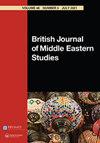阻力轴与中东地区秩序:列线、空间和规范性替代
IF 0.6
4区 社会学
Q2 AREA STUDIES
引用次数: 0
摘要
阿拉伯起义10年过去了,整个中东地区的政治仍存在争议,无论是国家内部还是国家之间。作为战略联盟、安全共同体和理念网络的混合体,鉴于其长期以来对-à-vis美国及其地区盟友的反霸权前景,抵抗轴心为中东地区秩序问题提供了令人信服的研究。虽然由许多组成部分组成,但将这个复杂的联盟网络结合在一起的是一个广泛共享的规范性愿景,即在话语中表达的区域秩序,由观念遗产驱动,并通过空间表现实现。我们把这种规范性的愿景称为nomos。在关注抵抗轴心时,本文着眼于轴心内的行动者(即伊朗伊斯兰共和国和真主党)部署空间化抵抗概念的方式。以黎巴嫩为实证重点,我们利用在该国进行的实地调查,探索通过双方创造的不同文化和纪念空间来表达抵抗叙事。我们的论点是,nomos作为一种替代概念工具,可以与更主流的方法一起理解秩序的表现形式。文章历史修订2022年12月12日接受2023年2月8日本文章由计算机程序翻译,如有差异,请以英文原文为准。
The resistance axis and regional order in the Middle East: nomos, space, and normative alternatives
A decade on from the Arab Uprisings, politics across the Middle East remains contested, both within and between states. As a mix of strategic alliance, security community, and ideational network, the Resistance Axis provides a compelling study into questions of regional order in the Middle East, given its long-standing counterhegemonic outlook vis-à-vis the US and its regional allies. While comprised of a number of constituent parts, what holds this complex alliance network together is a broadly shared normative vision of regional order articulated in discourse, driven by ideational heritage and made real through spatial performance. We refer to this normative vision as nomos. In focusing on the Resistance Axis, this paper looks at the ways in which spatialized notions of resistance have been deployed by actors within the axis, namely the Islamic Republic of Iran and Hezbollah. With an empirical focus on Lebanon, we draw on fieldwork conducted in the country exploring the articulation of resistance narratives through different cultural and memorialized spaces that both actors have created. Our contention is that nomos has a utility as an alternative conceptual tool for understanding manifestations of order alongside more mainstream approaches. ARTICLE HISTORY Revised 12 December 2022 Accepted 8 February 2023
求助全文
通过发布文献求助,成功后即可免费获取论文全文。
去求助
来源期刊
CiteScore
2.00
自引率
11.10%
发文量
75
期刊介绍:
The British Journal of Middle Eastern Studies is a refereed academic journal published for the British Society for Middle Eastern Studies (popularly known as BRISMES). Founded in 1974 as the BRISMES Bulletin, the British Journal of Middle Eastern Studies assumed its present title in 1991 reflecting its growth into a fully-fledged scholarly journal. The editors aim to maintain a balance in the journal"s coverage between the modern social sciences and the more traditional disciplines associated with Middle Eastern and Islamic Studies. They welcome scholarly contributions on all aspects of the Middle East from the end of classical antiquity and the rise of Islam.

 求助内容:
求助内容: 应助结果提醒方式:
应助结果提醒方式:


